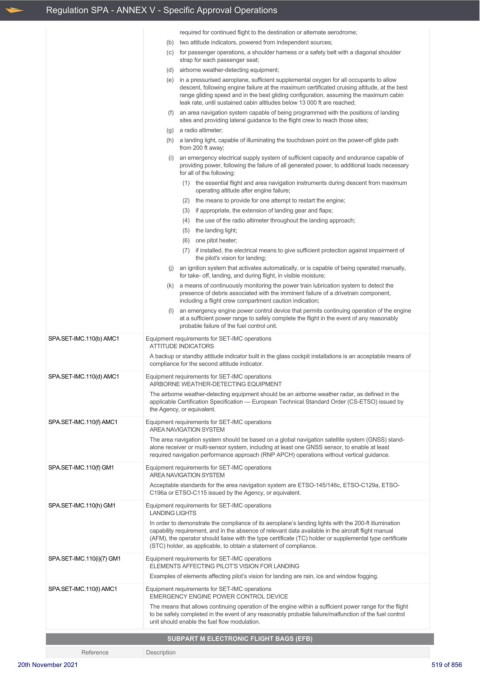Page 519 - UK Air Operations Regulations (Consolidated) 201121
P. 519
~
~ Regulation SPA - ANNEX V - Specific Approval Operations Centrik
required for continued flight to the destination or alternate aerodrome;
(b) two attitude indicators, powered from independent sources;
(c) for passenger operations, a shoulder harness or a safety belt with a diagonal shoulder
strap for each passenger seat;
(d) airborne weather-detecting equipment;
(e) in a pressurised aeroplane, sufficient supplemental oxygen for all occupants to allow
descent, following engine failure at the maximum certificated cruising altitude, at the best
range gliding speed and in the best gliding configuration, assuming the maximum cabin
leak rate, until sustained cabin altitudes below 13 000 ft are reached;
(f) an area navigation system capable of being programmed with the positions of landing
sites and providing lateral guidance to the flight crew to reach those sites;
(g) a radio altimeter;
(h) a landing light, capable of illuminating the touchdown point on the power-off glide path
from 200 ft away;
(i) an emergency electrical supply system of sufficient capacity and endurance capable of
providing power, following the failure of all generated power, to additional loads necessary
for all of the following:
(1) the essential flight and area navigation instruments during descent from maximum
operating altitude after engine failure;
(2) the means to provide for one attempt to restart the engine;
(3) if appropriate, the extension of landing gear and flaps;
(4) the use of the radio altimeter throughout the landing approach;
(5) the landing light;
(6) one pitot heater;
(7) if installed, the electrical means to give sufficient protection against impairment of
the pilot's vision for landing;
(j) an ignition system that activates automatically, or is capable of being operated manually,
for take- off, landing, and during flight, in visible moisture;
(k) a means of continuously monitoring the power train lubrication system to detect the
presence of debris associated with the imminent failure of a drivetrain component,
including a flight crew compartment caution indication;
(l) an emergency engine power control device that permits continuing operation of the engine
at a sufficient power range to safely complete the flight in the event of any reasonably
probable failure of the fuel control unit.
SPA.SET-IMC.110(b) AMC1 Equipment requirements for SET-IMC operations
ATTITUDE INDICATORS
A backup or standby attitude indicator built in the glass cockpit installations is an acceptable means of
compliance for the second attitude indicator.
SPA.SET-IMC.110(d) AMC1 Equipment requirements for SET-IMC operations
AIRBORNE WEATHER-DETECTING EQUIPMENT
The airborne weather-detecting equipment should be an airborne weather radar, as defined in the
applicable Certification Specification — European Technical Standard Order (CS-ETSO) issued by
the Agency, or equivalent.
SPA.SET-IMC.110(f) AMC1 Equipment requirements for SET-IMC operations
AREA NAVIGATION SYSTEM
The area navigation system should be based on a global navigation satellite system (GNSS) stand-
alone receiver or multi-sensor system, including at least one GNSS sensor, to enable at least
required navigation performance approach (RNP APCH) operations without vertical guidance.
SPA.SET-IMC.110(f) GM1 Equipment requirements for SET-IMC operations
AREA NAVIGATION SYSTEM
Acceptable standards for the area navigation system are ETSO-145/146c, ETSO-C129a, ETSO-
C196a or ETSO-C115 issued by the Agency, or equivalent.
SPA.SET-IMC.110(h) GM1 Equipment requirements for SET-IMC operations
LANDING LIGHTS
In order to demonstrate the compliance of its aeroplane’s landing lights with the 200-ft illumination
capability requirement, and in the absence of relevant data available in the aircraft flight manual
(AFM), the operator should liaise with the type certificate (TC) holder or supplemental type certificate
(STC) holder, as applicable, to obtain a statement of compliance.
SPA.SET-IMC.110(i)(7) GM1 Equipment requirements for SET-IMC operations
ELEMENTS AFFECTING PILOT’S VISION FOR LANDING
Examples of elements affecting pilot’s vision for landing are rain, ice and window fogging.
SPA.SET-IMC.110(l) AMC1 Equipment requirements for SET-IMC operations
EMERGENCY ENGINE POWER CONTROL DEVICE
The means that allows continuing operation of the engine within a sufficient power range for the flight
to be safely completed in the event of any reasonably probable failure/malfunction of the fuel control
unit should enable the fuel flow modulation.
SUBPART M ELECTRONIC FLIGHT BAGS (EFB)
Reference Description
20th November 2021 519 of 856

